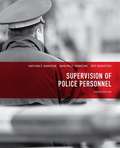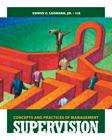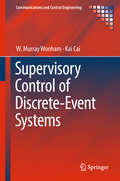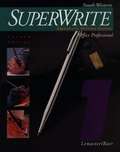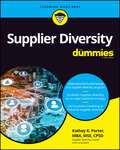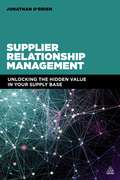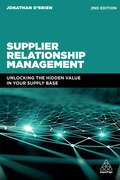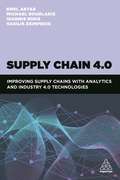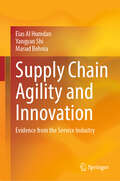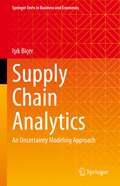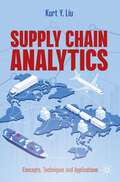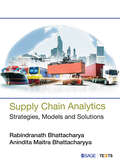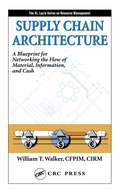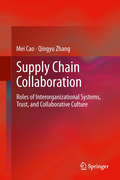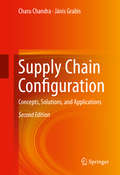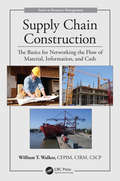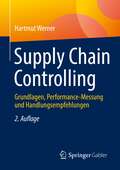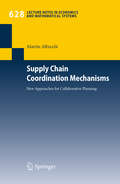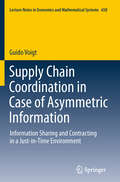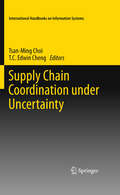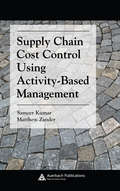- Table View
- List View
Supervision of Police Personnel (Eighth Edition)
by Nathan F. Iannone Marvin D. Iannone Jeff BernsteinThe must-read text for criminal justice students, prospective police supervisors, and police promotional exams. Supervision of Police Personnel, Eighth Edition, offers complete coverage of the principles and practices of police supervision for leadership training of supervisors in law enforcement and allied fields. This newly updated text explores relationships involved in individual and group management methods and the practical techniques for carrying out the various responsibilities of the police supervisor. Discussions focus on real issues faced by police supervisors in interpersonal, operational, and administrative relationships. Written by experienced police officers, the text presents time-tested content that is an indispensible resource for promotional exams.
Supervision: Concepts and Practices of Management (Eleventh Edition)
by Raymond L. Hilgert Edwin C. LeonardSUPERVISION: CONCEPTS AND PRACTICES OF MANAGEMENT, 11E helps readers develop the key supervisory skills that will make the difference in today's rapidly changing business world. This comprehensive, single source for supervision success combines proven, traditional management principles and up-to-the-minute leadership insights with innovative, everyday practices and proven skill-building applications. The latest edition taps into the author's wealth of first-hand business experience to explore some of today's most pressing business topics, including globalization, managing through economic turbulence, transitional and temporary workers, virtual employees, technology and its effects on supervision, outsourcing and downsizing, diversity, and ethics. Readers experience, rather than simply read about, today's supervisory challenges as captivating cases as well as new video cases from actual well-known organizations throughout the text place students into the role of supervisor. Exercises and memorable examples help them better understand and refine interpersonal communication, decision-making, conflict resolution and the other supervisory skills most important for leading individuals and teams to success.
Supervisory Control of Discrete-Event Systems (Communications and Control Engineering)
by Kai Cai W. Murray WonhamThis book shows how supervisory control theory (SCT) supports the formulation of various control problems of standard types, like the synthesis of controlled dynamic invariants by state feedback, and the resolution of such problems in terms of naturally definable control-theoretic concepts and properties, like reachability, controllability and observability. It exploits a simple, abstract model of controlled discrete-event systems (DES) that has proved to be tractable, appealing to control specialists, and expressive of a range of control-theoretic ideas. It allows readers to choose between automaton-based and dually language-based forms of SCT, depending on whether their preference is for an internal-structural or external-behavioral description of the problem. The monograph begins with two chapters on algebraic and linguistic preliminaries and the fundamental concepts and results of SCT are introduced. To handle complexity caused by system scale, architectural approaches—the horizontal modularity of decentralized and distributed supervision and the vertical modularity of hierarchical supervision—are introduced. Supervisory control under partial observation and state-based supervisory control are also addressed; in the latter, a vector DES model that exploits internal regularity of algebraic structure is proposed. Finally SCT is generalized to deal with timed DES by incorporating temporal features in addition to logical ones. Researchers and graduate students working with the control of discrete-event systems or who are interested in the development of supervisory control methods will find this book an invaluable aid in their studies. The text will also be of assistance to researchers in manufacturing, logistics, communications and transportation, areas which provide plentiful examples of the class of systems being discussed.
Supervisory Control of Discrete-Event Systems (Communications and Control Engineering)
by Kai Cai W. Murray WonhamThis book shows how supervisory control theory (SCT) supports the formulation of various control problems of standard types, like the synthesis of controlled dynamic invariants by state feedback, and the resolution of such problems in terms of naturally definable control-theoretic concepts and properties, like reachability, controllability and observability. It exploits a simple, abstract model of controlled discrete-event systems (DES) that has proved to be tractable, appealing to control specialists, and expressive of a range of control-theoretic ideas. It allows readers to choose between automaton-based and dually language-based forms of SCT, depending on whether their preference is for an internal-structural or external-behavioral description of the problem. The monograph begins with two chapters on algebraic and linguistic preliminaries and the fundamental concepts and results of SCT are introduced. To handle complexity caused by system scale, architectural approaches—the horizontal modularity of decentralized and distributed supervision and the vertical modularity of hierarchical supervision—are introduced. Supervisory control under partial observation and state-based supervisory control are also addressed; in the latter, a vector DES model that exploits internal regularity of algebraic structure is proposed. Finally SCT is generalized to deal with timed DES by incorporating temporal features in addition to logical ones. Researchers and graduate students working with the control of discrete-event systems or who are interested in the development of supervisory control methods will find this book an invaluable aid in their studies. The text will also be of assistance to researchers in manufacturing, logistics, communications and transportation, areas which provide plentiful examples of the class of systems being discussed.
Superwrite: Alphabetic Writing System, Office Professional (Volume 1, 2nd Edition)
by A. James Lemaster John BaerVolume One introduces SuperWrite theory and beginning transcription principles. The step-by-step approach to writing principles guides students to alphabetic writing success. Eight lessons develop personal success factors such as goal-setting, problem-solving, time management, attendance, and promptness. Updated keyboarding style references reflect current business practices.
Supplier Diversity For Dummies
by Kathey K. PorterExtend the principles of diversity and inclusion to your company's suppliers Many people are familiar with the importance of ensuring and advancing inclusion, equity, and diversity amongst their employees and managers. But do your efforts include supplier diversity—an equally as important and essential part of any holistic diversity effort? In Supplier Diversity For Dummies, nationally recognized small business strategist and economic inclusion and supplier diversity expert Kathey Porter delivers an empowering and informative guide to implementing this integral part of any robust inclusion initiative: supplier diversity. You'll understand the relevance of supplier diversity and why it's important to encourage equal opportunity for diverse suppliers and businesses owned and managed by underrepresented groups. In this book, you'll also find: The answers to your most pressing questions about how to build a coherent and sustainable supplier diversity program Ways to contribute more fully to your company's diversity and inclusion functions Strategies to position supplier diversity as a central function in your organization Perfect for company buyers, purchasing and procurement professionals, material management executives, strategic souring professionals and supplier diversity practitioners, Supplier Diversity For Dummies is a must-read resource for supply chain professionals, diversity and inclusion leaders and anyone looking to increase their proficiency in supplier diversity, improve supply chain inclusivity and increase their social impact.
Supplier Relationship Management
by Jonathan O'BrienSupplier Relationship Management (SRM) is a strategic and structured approach to identify, and maximise value from, key and strategic suppliers. This book is a practical guide for anyone wanting to understand and implement the right approaches to get the most from the supply base. It is not about creating complex systems that require an army to support them but about developing clarity of focus so you are able to direct what resources you have at the suppliers who can make the biggest difference to your organization now and in the future.
Supplier Relationship Management: Unlocking the Hidden Value in Your Supply Base
by Jonathan O'BrienSupplier Relationship Management enables organizations to secure vast value from their supply base by determining the suppliers that are important or hold potential and, based upon what makes them important or even strategic, putting in place interventions unique to each supplier to unlock real tangible benefits. This second edition delivers a framework of resources for anyone who manages or interfaces with important suppliers, for contract management, to understand and manage the supply chain or to establish joint, collaborative relationships with the critical few strategic suppliers who can help bring new competitive advantage. A proven approach for supply base segmentation is included, together with tools and approaches for supplier performance measurement and driving improvements. Written by an award-winning author and leading practitioner in the field, the fully revised second edition of Supplier Relationship Management clarifies links between procurement and supply chain management, and explains how 'The Orchestra of SRM®'approach helps design a highly effective SRM program that will give the greatest return for our efforts. "This book is an ideal companion to Category Management in Purchasing and Negotiation for Procurement Professionals, also published by Kogan Page. Used together, these books provide a complete and powerful strategic purchasing toolkit."
Supplier Relationship Management: Unlocking the Value in Your Supply Base
by Jonathan O'BrienEffective supplier relationship management enables organizations to unlock value from their supply base and reap tangible benefits. With practical tips and a proven approach, this is the guide to understanding how to maximize the potential of suppliers to gain a competitive advantage, get more innovation and drive sustainability.Supplier Relationship Management explains the importance of ongoing supplier management, how to measure and improve their performance, and for the critical few that can make a dramatic difference to our organization, drive in and future-proof strategic collaborative relationships. The Orchestra of SRM® framework, coupled with expert tips, tools and resources, delivers clear guidance on how to design an effective supplier relationship management program, with maximum return on time and investment.Written by leading procurement expert, Jonathan O'Brien, this third edition offers new content on how to adapt to the huge changes we have seen across supply bases in recent years, and the new risks and challenges organizations face in managing key suppliers. It includes new information on driving sustainability, the future of the supply base, and how to secure more innovation from our suppliers. Supplier segmentation is outlined in more detail and there is new information on how companies are managing supply chains, and the impacts of this in practice. A practical guide to unlock the new value from your key suppliers in a changing world.
Supplies Management for Health Services (Routledge Revivals)
by Stanley HymanFirst published in 1979, Supplies Management for Health Services looks at the characteristics and problems of hospital suppliers and examines the way in which the hospital and the National Health Service deal with supplies problems and relations with suppliers. Beginning with a description of the National Health Service and its supplies’ organisations and the role of the Department of Health and Social Security in this field, the book then reports on the detailed studies made over two years of the supplies’ problems of ten London area health authorities and ten London manufacturers of medical equipment. The NHS situation is then contrasted with the supplies’ situation in three non-health organisations and with the health supplies situation in France and West Germany. The final part of the book analyses the information obtained, proposes a means of assessing supplies systems, and evaluates the NHS situation. This is followed by the realistic proposals for reform, advocating a system similar to that used in British defence services, based on a central procurement agency, close cooperation with private manufacturers, and manufacture by government where necessary. This book will surely interest students of economics and global health.
Supply Chain 4.0: Improving Supply Chains with Analytics and Industry 4.0 Technologies
by Vasileios Zeimpekis Ioannis Minis Dr Emel Aktas Professor Michael Bourlakis'Supply Chain 4.0' has introduced automation into logistics and supply chain processes, exploiting predictive analytics to better match supply with demand, optimizing operations and using the latest technologies for the last mile delivery such as drones and autonomous robots. Supply Chain 4.0 presents new methods, techniques, and information systems that support the coordination and optimization of logistics processes, reduction of operational costs as well as the emergence of entirely new services and business processes.This edited collection includes contributions from leading international researchers from academia and industry. It considers the latest technologies and operational research methods available to support smart, integrated, and sustainable logistics practices focusing on automation, big data, Internet of Things, and decision support systems for transportation and logistics. It also highlights market requirements and includes case studies of cutting-edge applications from innovators in the logistics industry.
Supply Chain Agility and Innovation: Evidence from the Service Industry
by Eias Al Humdan Yangyan Shi Masud BehniaThis book critically examines the concept of 'supply chain agility' (SCA) in a novel context, shedding light on its implications for executives and professionals. While much literature has explored SCA in manufacturing, this book pioneers a comprehensive exploration of its application in the service sector, an often-overlooked domain in operations management, supply chain management, and innovation literature. The analysis, based on data from 245 service firms in Australia, employs a unique approach, revealing a positive relationship between firm innovativeness and SCA, with SCA in turn positively impacting firm performance. By bridging gaps in previous research, this book offers conceptual, methodological, and empirical contributions, emphasizing the critical role of innovation in achieving SCA, particularly in uncertain contexts. It provides valuable insights for firms navigating the service economy, offering a holistic examination of the benefits of SCA and empirically validating its role in managing market changes cost-effectively for a competitive advantage. The findings encourage a re-evaluation of firm performance, urging business professionals and managers to adopt a comprehensive perspective. The insights presented serve as a valuable tool for measurement, estimation, assessment, and benchmarking—key drivers for improving and predicting performance in dynamic supply chain environments. Overall, this book is a timely and essential resource for those seeking to understand and enhance supply chain agility in the evolving landscape of the service industry.
Supply Chain Analytics: An Uncertainty Modeling Approach (Springer Texts in Business and Economics)
by Işık BiçerThis textbook offers a detailed account of analytical models used to solve complex supply chain problems. It introduces a unique risk analysis framework that helps the reader understand the sources of uncertainties and use appropriate models to improve decisions in supply chains. This framework illustrates the complete supply chain for a product and demonstrates the supply chain's exposure to demand, supply, inventory, and financial risks. Step by step, this book provides a detailed examination of analytical methods that optimize operational decisions under different types of uncertainty. It discusses stochastic inventory models, introduces uncertainty modeling methods, and explains methods for managing uncertainty. To help readers deepen their understanding, it includes access to various supplementary material including an online interactive tool in Python. This book is intended for undergraduate and graduate students of supply chain management with a focus on supply chain analytics. It also prepares practitioners to make better decisions in this field.
Supply Chain Analytics: Concepts, Techniques and Applications
by Kurt Y. LiuThis innovative new core textbook, written by an experienced professor and practitioner in supply chain management, offers a business-focused overview of the applications of data analytics and machine learning to supply chain management. Accessible yet rigorous, this text introduces students to the relevant concepts and techniques needed for data analysis and decision making in modern supply chains and enables them to develop proficiency in a popular and powerful programming software. Suitable for use on upper-level undergraduate, postgraduate and MBA courses in supply chain management, it covers all of the major supply chain processes, including managing supply and demand, warehousing and inventory control, transportation and route optimization. Each chapter comes with practical real-world examples drawn from a range of business contexts, including Amazon and Starbucks, case study discussion questions, computer-assisted exercises and programming projects.
Supply Chain Analytics: Strategies, Models and Solutions
by Rabindranath Bhattacharya Anindita M. BhattacharyyaAn easy-to-read textbook that will help students to understand and appreciate the concepts and decision-making processes of supply chain management through analytics. This book presents the concepts, strategies and models related to supply chains. Using accessible quantitative models, it provides a unified framework for supply chain analytics for products - right from sourcing to manufacturing to delivery to remanufacturing, which closes the supply chain. The book synthesizes a collection of analytical models in the context of both formulation and solution of the problems in all the areas of supply chain. The textbook provides its readers with the tools and skills necessary to understand supply chains analytically and quantitatively and opens opportunities for them to play around with the concepts through exercises and examples. This book will be ideal for students of management who want to get a better understanding of supply chain analytics. Key Features: • Contains over 10 case studies of real Indian companies - their supply chain problems and solutions • Includes sections on system dynamic models, stochastic models and chapters on remanufacturing models and simulation modelling • Uses Microsoft Excel solver to help students easily grasp the mathematics behind the models and experiment with the problems themselves.
Supply Chain Architecture: A Blueprint for Networking the Flow of Material, Information, and Cash (Resource Management)
by William T. Walker"The book is highly readable, informative, thought provoking, and educational.At every stage, Walker challenges the reader to move away from conventional supply chain thinking to a broader-view, highly concise approach that focuses on the organization's objectives. The book will help you visualize a supply network and develop a blueprint for your
Supply Chain Close-Up: The Video Vault
by V. G. Narayanan Lisa BremThe owners of the Video Vault struggle to determine the optimal stocking levels of home videos in an industry fraught with new technology, new pricing paradigms, and stiff competitive pressure from large national chains. Teaching Purpose: To demonstrate the role of incentive contracts in achieving supply chain coordination.
Supply Chain Collaboration
by Qingyu Zhang Mei CaoTo survive and thrive in the competition, firms have strived to achieve greater supply chain collaboration to leverage the resources and knowledge of suppliers and customers. Internet based technologies, particularly interorganizational systems, further extend the firms' opportunities to strengthen their supply chain partnerships and share real-time information to optimize their operations. Supply Chain Collaboration: Roles of Interorganizational Systems, Trust, and Collaborative Culture explores the nature and characteristics, antecedents, and consequences of supply chain collaboration from multiple theoretical perspectives. Supply Chain Collaboration: Roles of Interorganizational Systems, Trust, and Collaborative Culture conceptualizes supply chain collaboration as seven interconnecting elements including information sharing, incentive alignment, goal congruence, decision synchronization, resource sharing, as well as communication and joint knowledge creation. These seven components define the occurrence of collaborative efforts and allow us to explain supply chain collaboration more precisely. Collaborative advantages are also divided into five components to capture the joint competitive advantages and benefits among supply chain partners. The definitions and measures developed here examine some central issue surrounding supply chain development but this is also followed up with real-life managerial practicalities. This balance of theory and practical application makes Supply Chain Collaboration: Roles of Interorganizational Systems, Trust, and Collaborative Culture a strong resource for industry practitioners and researchers alike.
Supply Chain Configuration
by Charu Chandra Janis GrabisThis book discusses the models and tools available for solving configuration problems, emphasizes the value of model integration to obtain comprehensive and robust configuration decisions, proposes solutions for supply chain configuration in the presence of stochastic and dynamic factors, and illustrates application of the techniques discussed in applied studies. It is divided into four parts, which are devoted to defining the supply chain configuration problem and identifying key issues, describing solutions to various problems identified, proposing technologies for enabling supply chain confirmations, and discussing applied supply chain configuration problems. Its distinguishing features are: an explicit focus on the configuration problem an in-depth coverage of configuration models an emphasis on model integration and application of information modeling techniques in decision-making New to this edition is Part II: Technologies, which introduces readers to various technologies being utilized for supply chain configuration and contains two new chapters. The volume also has an added emphasis on the most recent theoretical developments and empirical findings in the area of supply chain management and related topics. This book is appropriate for professional and technical readers, including research directors, research associates, and institutions involved in both the design and implementation of logistics systems in manufacturing and service-related products. An equally appropriate audience is the academic reader, including professors, research associates, and students in industrial, manufacturing, mechanical, and automotive engineering departments, as well as engineering management, management sciences, and production and operations management.
Supply Chain Construction: The Basics for Networking the Flow of Material, Information, and Cash (Resource Management)
by William T. WalkerAll too often, entrepreneurs start small businesses unaware of their need for a supply chain network. And, large companies are acquired and their product lines merged with little regard for supply chain network integration and rationalization. Written for practitioners by a practitioner with 40 years of experience, Supply Chain Construction: The Ba
Supply Chain Controlling: Grundlagen, Performance-Messung und Handlungsempfehlungen
by Hartmut WernerDas Supply Chain Controlling ermöglicht es, die Bereiche zur Kostensenkung innerhalb moderner Lieferketten aufzudecken. In diesem Buch wird eine Ausgestaltung des Supply Chain Controllings aufgezeigt. Zu den Instrumenten zählen Kennzahlensysteme und Werttreiberbäume. Außerdem werden moderne Performance-Measurement-Systeme vorgestellt, wie beispielsweise die Supply Chain Scorecard. Abweichungen zu gesetzten Zielvorgaben lassen sich über ein Cost Tracking geeigneter Spitzenwerte sowie moderne Hard-(Soft)-Analysen messen. Aber auch das Working Capital Management und Konzepte des Strategischen Kostenmanagements (Target Costing, Prozesskostenrechnung, Lifecycle Costing, Total-Cost-of-Ownership) gehören dazu. Schließlich trägt wohl kein anderer Bereich zu einer dauerhaften Wertsteigerung von Organisationen bei, wie die Wertschöpfungskette, deren Effekte sich über den Economic Value Added messen lassen.Die 2. Auflage wurde vollständig überarbeitet und erweitert mit neuen Kapiteln zu den aktuellen Untersuchungsbereichen Digitales Supply Chain Controlling und Resilientes Supply Chain Controlling.
Supply Chain Coordination Mechanisms
by Martin AlbrechtIntegrated supply chain planning is well understood by theory and widely applied in practice - however, only with respect to intra-organisational supply chains. In inter-organisational supply chains, an additional, yet unresolved problem arises: due to confidentiality reasons, decentralized parties keep their local data private, which prevents an integrated planning. Local planning procedures such as upstream planning, which are usually applied then, result in suboptimal solutions for the supply chain as a whole. In this work, new mechanisms for inter-organizational, collaborative supply chain planning are presented. These mechanisms are able to identify the systemwide optimum for several classes of supply chain planning problems. They can be applied by two or more self-interested parties and do not require a trusted third party. Extensive computational tests for randomly generated and real-word data suggest a favorable performance of these mechanisms.
Supply Chain Coordination in Case of Asymmetric Information
by Guido VogtInformation sharing is frequently promoted as a mean to improve the supply chain performance. This work shows the results of behavioral experiments, in which the participants share private information in order to influence the contract terms in a Just-in-Time environment. It is shown that the impact of information sharing is ambiguous, and dependent on several factors, such as contract flexibility and complexity or the interacting behavioral types. The experimental results form the basis for a behavioral principal-agent model that gives valuable insights on how the interaction of trust, trustworthiness and the information sharing strategy impacts the supply chain performance.
Supply Chain Coordination under Uncertainty
by T.C. Edwin Cheng Tsan-Ming ChoiChannel coordination is a core subject of supply chain management. Over the past decade, much research effort has been devoted to exploring the detailed mechanisms for achieving supply chain coordination under uncertainty, generating many fruitful analytical and empirical results. Despite the abundance of research results, there is an absence of a comprehensive reference source that provides state-of-the-art findings on both theoretical and applied research on the subject. In addition, with the advance of knowledge and technologies, many new topics on supply chain coordination under uncertainty have appeared in recent years. This handbook extensively examines supply chain coordination challenges with a focal point on discovering innovative measures that can help tackle the existing and emerging challenges. The book is organized into five parts, which include chapters on innovative analytical models for coordination, channel power and bargaining, technological advancements and applications, empirical analysis, cases studies and review. This handbook provides new empirical and analytical results with precious insights, which will not only help supply chain agents to understand more about the latest measures for supply chain coordination under uncertainty, but also help practitioners and researchers to know how to improve supply chain performance based on innovative methods.
Supply Chain Cost Control Using Activity-Based Management (Supply Chain Integration Modeling, Optimization and Application)
by Matthew ZanderHaving an accurate assessment of company expenditures is a key to staying in business. Activity-based management (ABM) is the only system that offers the tools to correctly assess the outflow involved in a tightly knit supply chain and enables understanding not only of the total cost of ownership (TCO), but also how these costs should be allocated.
